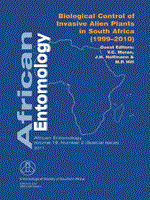Starting in 2007, two weedy sunflower species, Tithonia rotundifolia (Mill.) S.F.Blake and Tithonia diversifolia (Hemsl.) A.Gray (Asteraceae: Heliantheae), were targeted for biological control in South Africa. Surveys conducted in their native range (Mexico) revealed that there were five potential biological control agents for T. rotundifolia, and three of these are currently undergoing host-specificity and performance evaluations in South Africa. Two leaf-feeding beetles, Zygogramma signatipennis (Stål) and Zygogramma piceicollis (Stål) (Coleoptera: Chrysomelidae), are the most promising biological control agents for T. rotundifolia: preliminary host-specificity trials suggest that they are adequately host-specific. The stem-boring beetle, Lixus fimbriolatus Boheman (Coleoptera: Curculionidae), is also highly damaging to T. rotundifolia, but its host range is yet to be determined. Two other stem-boring beetles, Canidia mexicana Thomson (Coleoptera: Cerambycidae) and Rhodobaenus auctus Chevrolat (Coleoptera: Curculionidae), have also been recorded on T. rotundifolia, and these will be considered for further testing if L. fimbriolatus is found to be unsuitable for release in South Africa. Only two insect species were imported as candidate agents on T. diversifolia, the leaf-feeding butterfly Chlosyne sp. (Lepidoptera: Nymphalidae), and an unidentified stem-boring moth (Lepidoptera: Tortricidae): the latter was tested in quarantine but rejected because it attacked several sunflower cultivars. Only one pathogen, Puccinia enceliae Dietel & Holw. (Uredinales: Pucciniaceae), was found that could potentially have been used as a biological control agent against the Tithonia species, but attempts to culture this rust were unsuccessful.
BioOne.org will be down briefly for maintenance on 17 December 2024 between 18:00-22:00 Pacific Time US. We apologize for any inconvenience.
How to translate text using browser tools
1 August 2011
Prospective Agents for the Biological Control of Tithonia rotundifolia (Mill.) S.F.Blake and Tithonia diversifolia (Hemsl.) A.Gray (Asteraceae) in South Africa
D.O. Simelane,
K.V. Mawela,
A. Fourie
ACCESS THE FULL ARTICLE
It is not available for individual sale.
This article is only available to subscribers.
It is not available for individual sale.
It is not available for individual sale.

African Entomology
Vol. 19 • No. 2
August 2011
Vol. 19 • No. 2
August 2011
Lixus fimbriolatus
Mexican sunflower
red sunflower
Zygogramma piceicollis
Zygogramma signatipennis




